For the 1980’s and early 90’s Hollywood seemed almost obsessed over making the next best action film. This is evidenced by the sheer number of action films that were released during this time, many of which would feature characters and actors that would become iconic in this crazed action cinema.
Some classics to emerge triumphant from this action film barrage to be considered are, respectively: “The Terminator”, “First Blood”, “Top Gun”, “Robocop”, “Lethal Weapon”, “Predator”, “Raiders of the Lost Ark”, and “Die Hard”. It is interesting to take notice of what these films had in common in terms of content, motifs, and messages, and how many of them, even today, are loved by so many people. It is even further astounding to observe that so many of these beloved action films came into peoples lives in such a short amount of time. With so many films having both flogged and captured the hearts and minds of so many people in such a short time frame, one must consider the potential influences these films had on society and how they helped form much of what subsequent generations now hold to be true regarding discourses of masculinity, femininity, and race.
All
of the films mentioned above have strong, extremely masculine white
males as the central character being portrayed. I say all, but with the
partial exception of one: “The Terminator”. While the story in “The
Terminator” quite often includes Arnold Schwarzenegger’s character in
full stereotypical masculine glory, the film(s) are at their core
centered on Linda Hamilton’s character, Sarah Connor, the mother of the
future “savior” of the human race, doing whatever she can to stay alive.
It is for this focus on the female heroine in the Terminator films that
I have chosen this text. Out of all the immensely popular action films
to come out of the 1980’s and early 90’s, James Cameron’s Terminator
films part one and two stick out from the salvo of other popular action
films in that they are shown depicting a heroine in mostly
non-stereotypical forms at the center of the films story, unless of
course you also consider Cameron’s other works, e.g. “Aliens” featuring
Sigourney Weaver as Ellen Ripley, and Mary Elizabeth Manstrantino’s
brilliant character Lindsey Brigman in “The Abyss”. I feel that while
the Terminator films were great pieces of revolutionary and progressive
entertainment in their own right, they were also fairly progressive and
innovative in their portrayal of femininity and masculinity in film;
however, this was not without problematical and stereotypical
representations holding these depictions back from being the truly
ground-breaking pioneers they could have been. In this essay I will
analyze the representations of femininity and masculinity, as well as
some racist issues (that nearly fell by the wayside in my pursuit of
Sarah Connor’s femininity and the Terminator’s masculinity that I
discovered during my dissection of The Terminator and Terminator 2:
Judgment Day.
I will first begin
with what I feel is the most interesting character in the series, Sarah
Connor. Sarah Connor is the mother of the future “savior” of the world,
and leader of the human resistance, John Connor. It is interesting to
watch Sarah’s progression as a character throughout these two films. We
first meet Sarah in “The Terminator” in a diner where she is a waitress.
She is clumsy, quiet, lonely, and vulnerable, but nonetheless hard
working. Throughout much of the first film, Sarah is the stereotypical
“damsel-in-distress” that we have seen in almost hundreds of films.
Sarah is much this way throughout nearly two-thirds of the film until
she is finally kidnapped by a man named Kyle Reese, who reveals himself
to be a soldier sent from the future to protect Sarah and more
specifically, her ability to reproduce and bear a child. He also reveals
to her that the child she had yet to bear would be the man to save the
world from a powerful race of machines. This knowledge that Reese
imparts wither her, sparks an interesting reaction within Sarah.
Initially becomes infused with forceful confidence and courage in
learning to defend herself in whatever ways necessary to stay alive.
Reese teaches her how to shoot a gun, use hand-to-hand combat, and even
how to make homemade bombs, all of which she is fully enthralled in the
processes of and is able to learn quickly. While this scene could be
seen as quite progressive in terms of femininity being portrayed as a
literal evolution on screen, one needs to remember that while Sarah may
indeed be learning skills that will make her strong in her defense of
herself, she still needs to be taught these skills. These skills and
“toughness” are not a natural part of her femininity.
To
emphasize this point even more so, consider the juxtaposition (even
literally, for she is standing next to him throughout the scene) of her
to Reese in this scene, who is by no coincidence, a marine. Marines have
frequently been “ideal” stereotypical representations of masculinity,
it would seem there would be no one better to teach her the ways to
being a “man” and the skills necessary pertaining to taking care of
herself. Interestingly, in this same scene, only moments later, Reese
begins crying and immediately upon seeing this, Sarah rushes to his
side, puts her arms around him in quite a motherly manner, as if caring
for a crying son, and asks him if everything is alright. They
subsequently profess their love for each other and Sarah succumbs to his
virgin (more about this later) advances, and Sarah becomes pregnant
with future leader of the human resistance.
The
very sudden and stark change in character for the both characters,
particularly in Sarah, came quite unexpectedly. It seemed that this
scene at the lonesome street side hotel came near full circle to where
it began. They arrive at the hotel with Sarah being both scared, and
vulnerable. She then learns how to protect herself and becomes almost
instantly more assertive and confident, then without missing a beat, she
instantly reverts back to her motherly role, then to a heterosexual
sexual role, and then literally to that of the role of a mother and
partner.
Soon
after this scene Reese is killed by the Terminator, which then turns to
kill Sarah. Here is where her newfound feministic, stereotype power
comes into play full force. She initially runs from the Terminator,
which technically could be viewed Sarah still as the damsel-in-distress
motif, but I contend that it is not. This time she is not just running
for her own life, but also for that of her unborn son’s, and she knows
that in order to preserve both lives she will need to end that of the
Terminator’s. She eventually coaxes the Terminator (now nothing but a
metal skeleton, more about this later also) and just as he is reaching
for Sarah’s neck to choke her, she crushes and kills him. This scene is
probably the most powerful in depicting Sarah as the feminist heroine
she is destined to become. The scene overall can be interpreted that
while the woman has the capacity to love (albeit in a heterosexual way)
and feels pain when that love is lost (Reese), she is also self-aware
enough to realize that having a strong, masculine figure nearby is not
necessary for her protection, let alone her survival, even against the
most brutal and ruthless of figures.
Her
crushing of the Terminator could very well be viewed in several
powerfully symbolic ways. The first of which could be femininities
triumph over masculinity in general. With Reese dead, Sarah needs no
assistance from any male in order to defeat the monstrous presence of
masculinity in her life, literally by crushing the very “framework”
(skeleton) in which it is presented. I also see the Terminator’s
outstretched arm, in full choking fashion to be a symbolic threat to
femininity in general. Even in “masculinity's” last dying breath at the
hands of femininity, the man is attempting to choke the life out of the
woman and whatever power she recently gained in order to defeat him. The
first film ends shortly after this scene with Sarah driving towards the
desert, now with a noticeably large pregnant abdomen. This scene
reinforces that while Sarah had fought so bravely in literally
destroying that which was oppressive to her in masculinity (albeit
stereotyped masculinity in the Terminator), it was apparent that her
central focus internally was on her role as a mother/reproductive
figure, which, non-coincidentally, is the ultimate symbol in femininity.
This only reinforces the films tendency to depict that which is natural
and inherent to women, will always be natural and inherent, no matter
what typically “masculine” skills and behaviors are acquired through a
woman’s life experience.
The
second film in the series, “Terminator 2: Judgment Day” also contains
many insightful commentaries regarding femininity, which, almost brings
itself full circle back to where Sarah began in “The Terminator”. At the
end of the first film we were left with a mental image of a powerful,
intelligent, and evolved woman. She had just defeated the Terminator (or
gender discrimination in general) by defying who she had always been
and by tapping into the inner strength she never knew she had (until she
met Kyle Reese of course). The first time we see Sarah in the second
film it is nearly 10 years later and she has been forced to stay in a
hospital for the mentally unstable. It is worthy to note here that she
is in the mental hospital because of what she had so assertively
described experiencing with the Terminator as well as what she had
learned about the future from Reese. One could also take this
symbolically in that when a woman is breaking out of her
heteronormative, stereotypic femininity, society tends to “lock them up”
and push them out of sight and out of mind, classifying them as radical
or even “crazy” for trying to break away from what the status quo,
especially if their knowledge brings a threat to the white masculine
male who, in the hospital, is represented as the balding, weak, but
intelligent Doctor in charge of Sarah’s “treatment”. We first see her
doing pull-ups, sweating, and wearing nothing but a tank top (clearly
without a bra; this could be because of dress regulations for patients
within the facility but I can also see how it could be read in open
protest to such “feminine” artifacts) and scrub pants. She is more
defined and physical looking than last time we saw Sarah, especially in
her arms which look particularly strong and defined, which,
non-coincidentally are typically markers of a stereotypically “ideal”
masculine man. She comes across as now an extremely capable woman, both
mentally and physically.
It
could be inferred that she is appropriating these actions, appearances,
and even aggression from men and using it to her own advantage, which I
believe she does. This appropriation can be illustrated by the scene
with her in the hospital and she uses the knowledge (the same knowledge
she had been institutionalized for) as well as her physicality in an
attempt to escape. But, once again, her powerful femininity only gets
her so far. As she is running down the hall to the elevator literally
runs into and subsequently falls down at the feet of the Terminator. But
this time this ideal figure of masculinity is not there to kill her, he
is there to save her. What a fascinating dialectic this is! In one case
the quintessential embodiment of masculinity is present in our feminist
heroines life to kill her, and now, that same figure is again present
in her life (one could argue that he was always present in her life,
even after the hydraulic press incident, within dreams and such), but
this time it is that same embodied masculinity she had fought so hard
against that is there to save and protect her.
As
the film progresses, Sarah gradually becomes more accepting of the
machine that had been sent to protect her. But this does not stop her
from continuing in the ways that Reese had so effectively taught her. As
a side note, in a comment from John, Sarah’s now 10 year old son, to
his friend, he mentions that part of the reason Sarah had been
institutionalized is because she had gone to Mexico (presumably that is
where she was going at the end of the first film) and used her
attractiveness and sexuality to gain knowledge about various weapons.
This is intriguing because even though she has certainly grown immensely
from the first time we saw the clumsy Sarah working in the diner, she
still acknowledges the power that she has innately as a woman. And, as
taken from what John stated, she uses it to her advantage in gaining
knowledge and power that will only push her further and further away
from those weak stereotypes she once was. But once again, it must be
remembered that everything she has become up to this point in the films
has been learned, meaning none of it was portrayed as natural or innate,
besides perhaps her ability to work hard, as well as her over arching
concern for survival-both for herself as well as her son.
Ultimately
however, the second film ends on a note that, as mentioned previous,
brings the progression of Sarah Connor’s feminism almost full circle
back to where she was when she first met Reese. In the concluding scenes
of the film Sarah and John are being relentlessly hunted down by a new
Terminator, the T-1000 (that looks nothing like the original model of
Terminator), with the original Terminator along side them primarily
protecting John. This scene comes at almost a let down to Sarah’s
character arc throughout the films story. Where she once was able to
outsmart and defeat a Terminator on her own, she now has once again
become the damsel-in-distress, requiring the “good” Terminator’s
protection in order to stay alive and protect her son. The “good”
Terminator eventually kills the “bad” Terminator and sacrifices himself
in behalf of Sarah and John that they may live on in peace. I see this
as problematic for Linda Hamilton’s portrayal of the character. Indeed,
she is still a very strong character (she at one point wields a shotgun
with only one mobile arm); she is still far from being independent.
She
still relies heavily on the protection of an immensely strong masculine
figure in order to be safe; showing that while a woman may be able to
exhibit a strong will for success and utterly survival, it will not be
enough. This reinforces this, and shows, even perhaps inadvertently,
that being a strong woman will only get you so far when the “bullets” of
life begin being fired before it will be absolutely necessary that a
white, masculine man step in and save the damsel.
On
another note, I also found the portrayal of masculinity in the films to
be worthy of mentioning in some length because of both the films
extremely stereotyped portrayals of masculinity as well as their
somewhat progressive nature regarding gender in some of the male
characters. I will begin with the most prominent masculine character in
the film series, the Terminator, played by Arnold Schwarzenegger. The
first time we see the Terminator, in both films, he is completely naked,
giving great attention to sheer over-the-top and hyper sexualized
nature of his body. The audience is immediately met with feelings of
intimidation and awe in respect to his blatant masculinity. In some
cases, these feelings were represented in characters that either laughed
(perhaps out of shock and fear) when they saw him naked or simply
stared, knowing full well that this man has power over all present. To
watch the reactions of the men versus the women when he is seen naked is
quite informative to observe. As was just stated, the men react mostly
with either humor or looks of intimidation, while the women either
appear appalled or incredibly enticed even by his mere presence. Such is
especially the case in the bar scene. The Terminator walks in naked and
demands the clothes, boots, and motorcycle of a man, of which the man
refuses. The Terminator then throws the man onto the hot stove and
demands the artifacts yet again, this time he is successful. This not
only reinforces gender stereotypes, and validates violence as being
redeemable, but also reinforces the heteronormative nature in the two
films (as a side note, In Terminator 3, the Terminator first appears in a
gay bar, of which the reactions are quite the opposite of what the bar
scene in Terminator 2 was like. With Terminator 3 being made almost 20
years after Terminator 2, could this be a commentary on the more
frequently visible departures from heteronormativity in today’s society?
An interesting thought indeed).
While
much of what the Terminator is in the film is extremely stereotyped
masculinity, there is, I feel, some aspects of the Terminator,
particularly in his relationship with John that I feel are progressive
and extend beyond his “machinistic” masculine stereotypes. Perhaps the
best example that would illustrate my point most fully is the scene
where John is teaching the Terminator how to play “High Five.” As quoted
from Sarah Connor’s voiceover in the scene: “Watching John with the
machine, it was suddenly so clear. The terminator wouldn't stop, it
would never leave him. It would never hurt him or shout at him or get
drunk and hit him or say it was too busy to spend time with him. And it
would die to protect him. Of all the would-be fathers that came over the
years, this thing, this machine, was the only thing that measured up.
In an insane world, it was the sanest choice.” (Terminator 2:Judgment
Day). This description of the Terminator when juxtaposed to John’s
foster father who is portrayed as lazy, and possibly even a drinker,
gives credibility to Sarah’s observation-which, coming from Sarah, is
profound in and of itself. Here is a “man”, one who had originally tried
to kill her ten years previous, suddenly becoming the primary father
figure for her ten year old son. Is this symbolically allowing brute
masculinity to be accepted, or to be overlooked? And if this model of a
man is in fact “ideal”, complete with all its capability of violence, is
also the ideal father figure to the “savior” of the human race, then
what is does that say about all the father’s who defy these stereotypes?
Kyle
Reese is one such figure in the films. Reese, although a marine and a
fighter, is ultimately a sensitive and vulnerable character. For
example, in the first film Reese explains to Sarah that he is a virgin.
When he states this to her, all of his subtly innocent characterizations
(not being familiar with certain phrases, objects, etc.) make sense,
and for a time, Sarah views him as the ideal father figure and spouse.
It is interesting to further observe how Sarah, originally loving
someone who defied the stereotypical masculinity (especially that of a
modern marine in terms of moral code) to subsequently looking to
someone, who she had originally feared because of his immense
masculinity and sheer power and control he represented, as a father
figure for her son. Whether this is a statement further backing my
thesis of these issue ultimately, coming full circle back to where these
characters and stereotypes began, despite seemingly taking “two steps
forward, one step backward”, I will not consider too strongly but feel
that the irony that is set forth in the Sarah-Reese-Terminator
“relationship” is too strong not to give adequate attention to.
This
sensitivity exhibited by Reese could also be extended towards John
Connor as well. This sensitivity seen in John, I feel is in fact
progressive in its display. John, despite initially being portrayed as
smart, rule-breaking, and disobedient thief, we observe later on that
John has the sincere capacity to love and to be sympathetic to one’s
needs, as is seen particularly in relation to his mother. Throughout the
second film, the “idealized man” in symbolic terms (as well as Sarah
Connor’s terms per mentioned previously), the Terminator, is the figure
that is constantly there, repeatedly saving and protecting Sarah (“the
woman”) and her son, John. However, we know that in the end, after the
“war” with the machines, that it will ultimately not be the insensitive
Terminator that wins, but will be the sensitive John Connor, one who
feels an honest and hopeful connection with and love for human beings.
Those qualities such as love, compassion, understanding, and sensitivity
have been traditionally attributed to be more feminine qualities, but
here they are perfectly alert in John, and it is those qualities that
will eventually save the human race, not the brutal savagery with no
regard for the human condition that the Terminator race carries with it.
This could be looked at as the ultimate triumph in femininity over
stereotypical masculinity. When looked at in a symbolic sense, the
Terminator’s as the “race” of masculinity and the human resistance as
the “race” of feminism, it makes sense.
In
conclusion, I found the Terminator films to be incredibly insightful
into how representations of masculinity and femininity are being
developed in the media and the progress that is made therein. I feel my
examinations and queer readings involving these topics of social justice
were based off keen observations of my own and did not try to analyze
the particular intent of the filmmaker, I merely made inferences
regarding these representations of femininity and masculinity. Despite
what progress was arguably made in the films with respect to these two
topics, I feel that my thesis of concerning these progressive ideals
while taking two steps forward in some instances, almost always take one
step back-reverting to age old stereotypes and representations. These
stereotypes, even in such blatant models such as what is contained in
the Terminator films, are clearly all but impossible to draw completely
away from in film for any lengthy amount of time before they draw us
back in like a magnet. Consider the films eventual conclusion: that when
all is said and done, saving motherhood and its reproductive
capabilities are central to the human existence and salvation.
In
order to protect this gift, a woman must be capable of taking care of
herself, but only to an extent. No matter how strong a woman may become,
such as Sarah Connor, she ultimately still needs a man with those
natural, innate, even hegemonic abilities that only a man can possess in
order to survive and be protected from the dangers of the world. Also,
consider that because of her role as a mother, it will never be herself
that is meant to save the world, it is her son; so she is almost
expected to behave completely altruistically in behalf of the welfare
and safety of her child. In the end I felt that both my initial
curiosity and research questions were both answered, as well as my
general thesis statement. There may be more truth then we realize with
the Terminator’s statement, “I’ll be back”, for if the seeming
progressive nature for purportedly definitive roles for both masculinity
and femininity revert back to the all too common stereotypes from which
these characters spring, the conceptualization of the “terminator” in
all it’s blatant masculine glory, will indeed “be back” again, and
again.


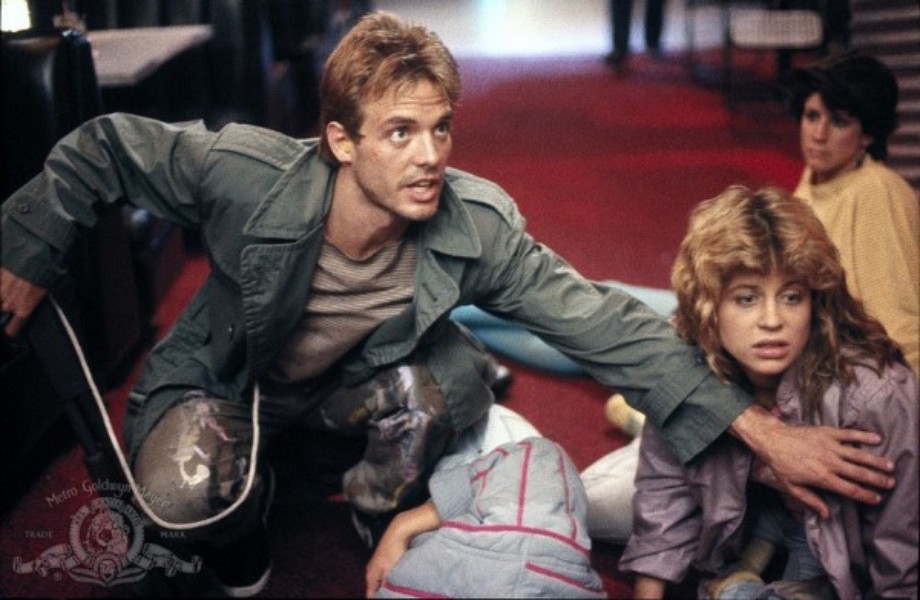
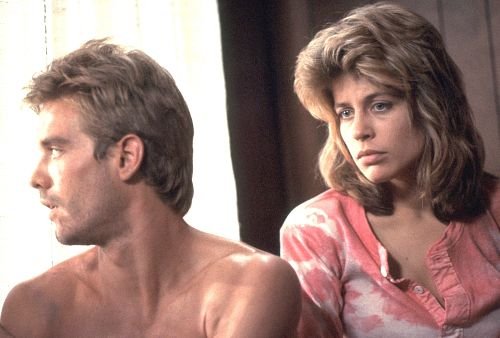
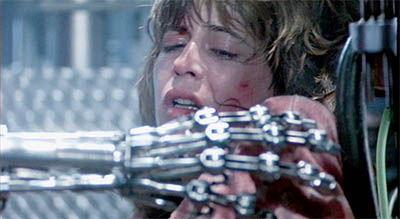

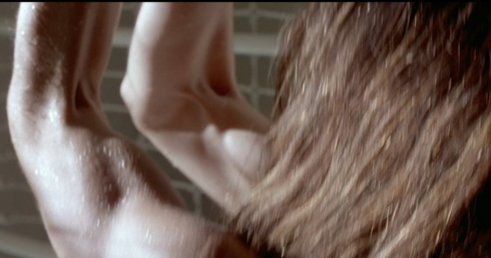
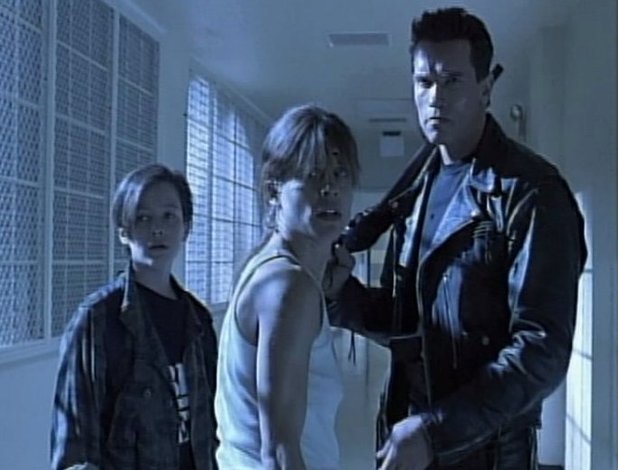

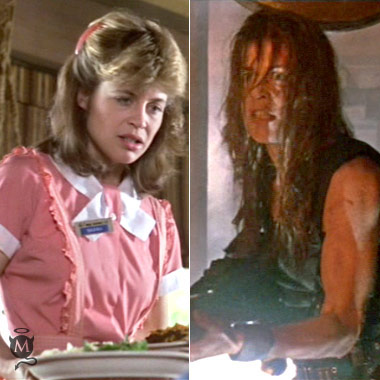
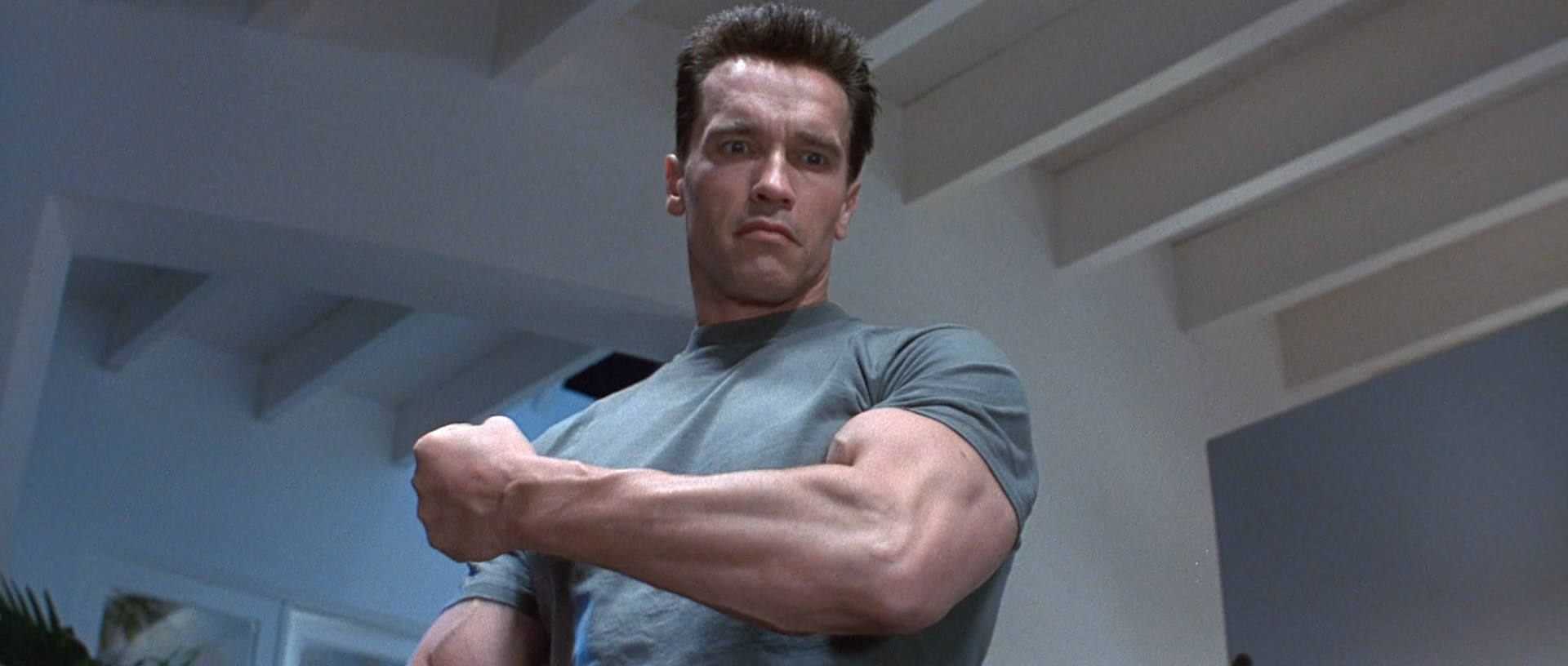

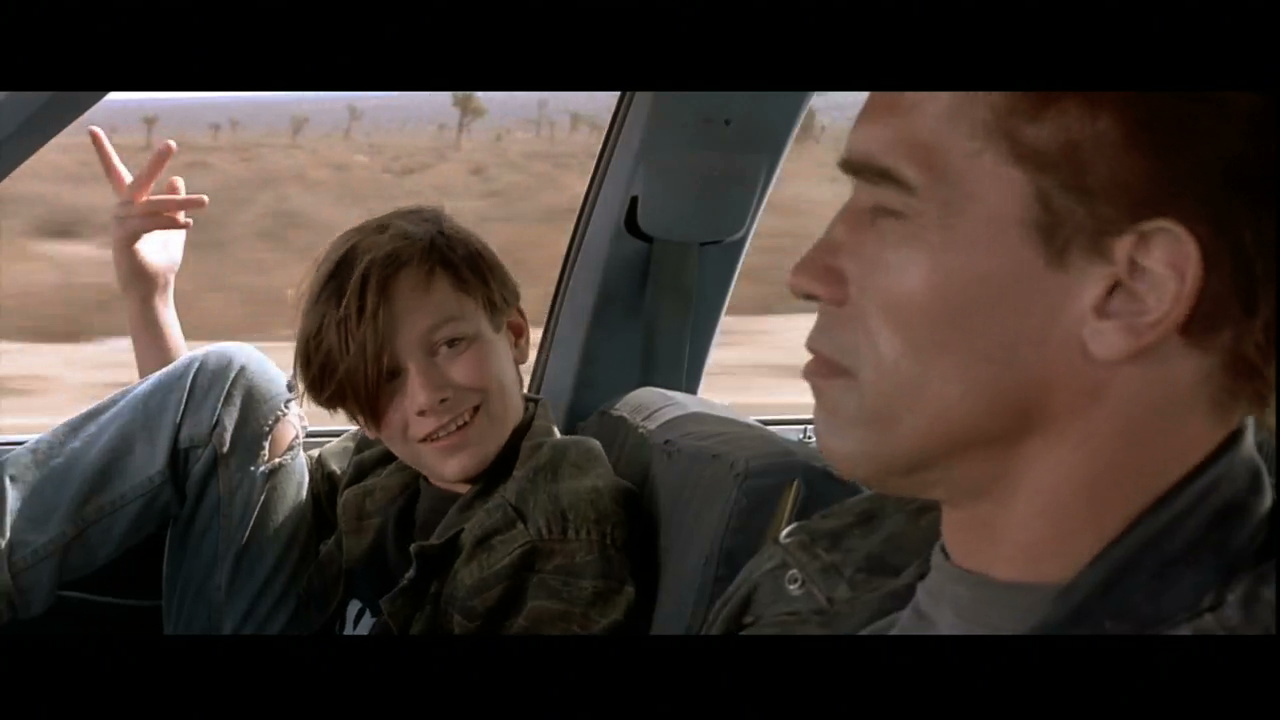
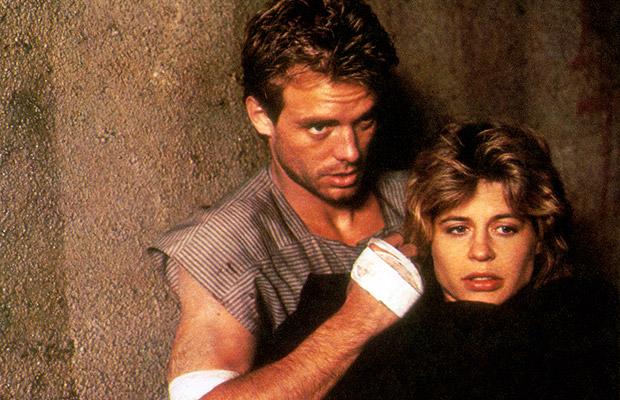
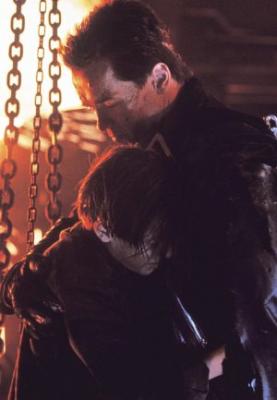

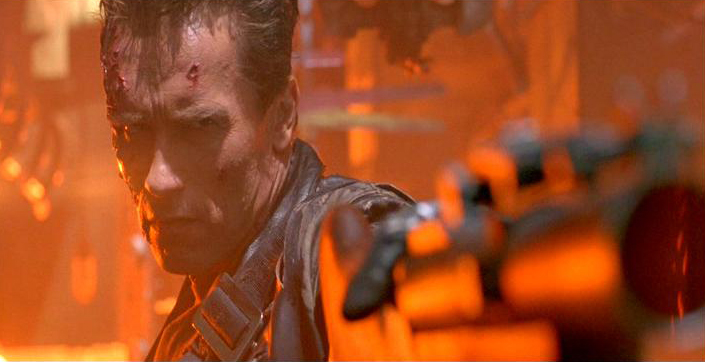
No comments:
Post a Comment